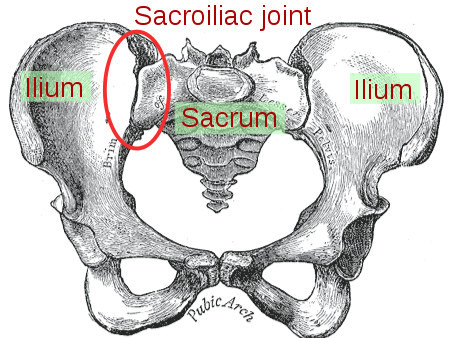Your sacroiliac joints (what we call your SI joints for short) are the main joints in your pelvis - they are the connection between your sacrum and ilium bones. These two joints are very important in many movements you do throughout the day - walking, running, standing. They are very big joints that absorb a lot of the force in your body when walking and/or running. Research tells us that SI joint dysfunction is to blame for about 15-30% of lower back pain.
| There are SO MANY ligaments and muscles that attach to our pelvis, a problem with one (or both) of your SI joints can present in your body as a variety of symptoms:
|
As we’ve discussed before, your body is always responding to different stresses: physical, emotional and chemical. The way your body reacts to these outside stresses is to get restrictions in your joints, which causes an inflammatory response in the joint and tissues surrounding that joint (what we call subluxations). That inflammatory response and lack of proper motion at that joint sends bad feedback to the brain, and our brain perceives some of this bad feedback as pain. When there continues to be a problem and stress response at that joint, the brain secretes stress hormones in our body, and our body cannot heal or function as it should.
| Can chiropractic help? Chiropractic care is one of the best ways to take care of your SI joints! In our office, the pelvis is one of the most important areas in your body that we work on everyday because it is the foundation to your spine. Over time, with specific chiropractic care, we can improve the motion in your SI joints, which helps to send GOOD feedback to your brain. This helps to lower the stress response in your brain, which enables the brain to send good feedback back to your body. This helps to enable your body to function better and heal in inflamed area. |
Your sacroiliac joints are very closely connected to how your core muscles activate. Your core muscles are vital for stabilizing your body, and your brain needs to know to activate these muscles in preparation for the most of the motions we do throughout the day on a daily basis. (Your brain knowing to prepare the muscles for movement is called the feed-forward mechanism.) A group of asymptomatic young men (meaning they did not have any pain) were tested to determine how their core muscles were activating with movement. (Basically if these muscles were “turning on” how they are supposed to during movements like lifting up their arm or leg.) About 20% of this group were shown to have core muscles that did not activate properly, which makes that person more prone to injury in the future. When this group with poor muscle activation was evaluated by a chiropractor, they were found to have misalignments at the SI joints or some type of SI joint dysfunction. Their SI joints were adjusted and the feed-forward mechanism was re-tested. After just that one adjustment, there was a 40% improvement in their ability to pre-activate their core musculature! (1)
What does study this tell us? It tells us that just because you don’t have symptoms or serious pain doesn’t mean there’s not a problem. We see this a lot in our office - a patient has had a desk job for years with general on and off low back stiffness, but never through much of it. One day, he or she bends over to pick up a piece of paper from the floor and gets a sharp, sometimes debilitating pain/injury. Most likely, this is not caused by bending over to pick up that piece of paper, this is usually caused by the build-up of different stresses in our lives that are affecting the communication between your brain and body on a nerological level for years.
1. Marshall P, Murphy B. The Effect of Sacroiliac Joint Manipulation on Feed-Forward Activation Times of the Deep Abdominal Musculature. J Manipulative Physiol Ther 2006; 29(3): 196-202.




 RSS Feed
RSS Feed
